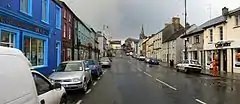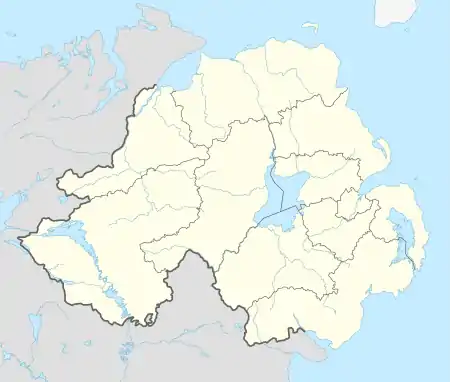Newtownstewart
Newtownstewart is a village and townland of 540 acres (219 ha) in County Tyrone, Northern Ireland. It is overlooked by hills called Bessy Bell and Mary Gray and lies on the River Strule below the confluence with its tributary the Owenkillew. It is situated in the historic barony of Strabane Lower and the civil parish of Ardstraw.[2] In the 2001 Census it had a population of 1,479 people. It lies within the Derry City and Strabane District Council area.
| Newtownstewart | |
|---|---|
 Main Street in Newtownstewart | |
 Newtownstewart Location within Northern Ireland | |
| Population | 1,551 (2011 Census) |
| District | |
| County | |
| Country | Northern Ireland |
| Sovereign state | United Kingdom |
| Post town | OMAGH |
| Postcode district | BT78 |
| Police | Northern Ireland |
| Fire | Northern Ireland |
| Ambulance | Northern Ireland |
| UK Parliament | |
| NI Assembly | |
History
The townland of Newtownstewart was historically called Lislas. It gained its current name when the land was granted to Sir William Stewart as part of the Plantation of Ulster.[1]
The Northern Bank building on the corner was the scene of an infamous murder in 1871 when bank cashier William Glass was robbed of £1,600 and killed. Assistant District Inspector Thomas Hartley Montgomery, of the Royal Irish Constabulary, who was in charge of the investigation, was subsequently tried, convicted, and hanged at Omagh Gaol.[upper-alpha 1]
.jpg.webp)
Places of interest
- The ruin of the Stewart Castle stands at the northern end of Main Street. The castle was built in 1619 during the Plantation of Ulster by Sir Robert Newcomen in an English manor house style. It suffered extensive damage during the Irish Rebellion of 1641 and its subsequent capture by Sir Phelim O' Neill, and in 1689 when King James' passed through the village while returning from the Siege of Derry to Dublin. The castle has remained a ruin ever since. An intact Bronze Age cist grave was found in that place, which was excavated in 1999.
- Three miles to the south west lies Baronscourt, the country seat of the Duke of Abercorn with its neo-classical mansion and ornate Italian style gardens, the home of the Duke of Abercorn's family since 1612. It also features an 18-hole golf course in the estate.
- Half a mile south-west of Newtownstewart, on a hill, is ruined Harry Avery's Castle, a 14th-century Gaelic stone castle - most unusual in Ulster. Only the massive D-shaped twin towers of the keep, built by Henry Aimbreidh O' Neil (Harry Avery O'Neill) (died 1392), are left.
Royal Visit
Prince Albert (later, George VI) and Lady Elizabeth Bowes-Lyon were married on 26 April 1923 in Westminster Abbey. The newlyweds' first visit as the Duke and Duchess of York was to Newtownstewart.
Sport
- Newtownstewart St. Eugene's is the local Gaelic Athletic Association club.
- Ardstraw Football Club is the local football club. They have a strong connection to the town with many players coming from within the town and the surrounding area
Demographics
2001 Census
Newtownstewart is classified as a village by the Northern Ireland Statistics and Research Agency (NISRA) (i.e. with population between 1,000 and 2,250). On Census day (29 April 2001) there were 1,479 people living in Newtownstewart. Of these:
- 22.8% were aged under 16 years and 18.7% were aged 60 and over
- 50.5% of the population were male and 49.5% were female
- 54.7% were from a Catholic background and 45.1% were from a Protestant background
- 5.8% of people aged 16–74 were unemployed
People
- Thomas Burnside (1782–1851), member of the United States House of Representatives from Pennsylvania and associate justice of the Supreme Court of Pennsylvania, born near Newtownstewart.
- Thomas Maclear (1794–1879), Astronomer Royal at the Cape of Good Hope, was born in Newtownstewart.
- Dukes of Abercorn, reside at Baronscourt, near Newtownstewart
- Johnny Loughrey, Irish singer born in Newtownstewart in 1945, died in 2005.
Transport
Construction of the Irish gauge (Irish Standard Gauge), Londonderry and Enniskillen Railway (L&ER) began in 1845 and reached Strabane in 1847. By 1852 it had extended to Newtownstewart and Omagh and its terminus in Enniskillen was reached in 1854. The company was absorbed into the Great Northern Railway (Ireland) in 1883.[5] Newtownstewart railway station opened on 9 May 1852 and finally closed on 15 February 1965.[6]
Notes
- There was a very early dramatisation in BBC television, of "Death at Newton-Stewart, a reconstruction of an unparalleled murder of the 'seventies, extracted from the records of the Ulster Assizes."[3]
References
- Placenames Database of Ireland
- "Townlands of County Tyrone". IreAtlas Townland Database. Retrieved 10 April 2015.
- Radio Times (6 February 1939), Death at Newton-Stewart, 62, BBC Television, p. 12
- Morris 1870, p. : between pages 50 and 51
- Patterson, Edward M (1962). The County Donegal Railways. Dawlish: David and Charles. pp. 10–11.
- "Newtownstewart station" (PDF). Railscot – Irish Railways. Retrieved 22 November 2007.
- Morris, Francis Orpen (1870), A Series of Picturesque Views of Seats of Noblemen and Gentlemen of Great Britain and Ireland, 4, London: William MacKenzie
External links
| Wikimedia Commons has media related to Newtownstewart. |